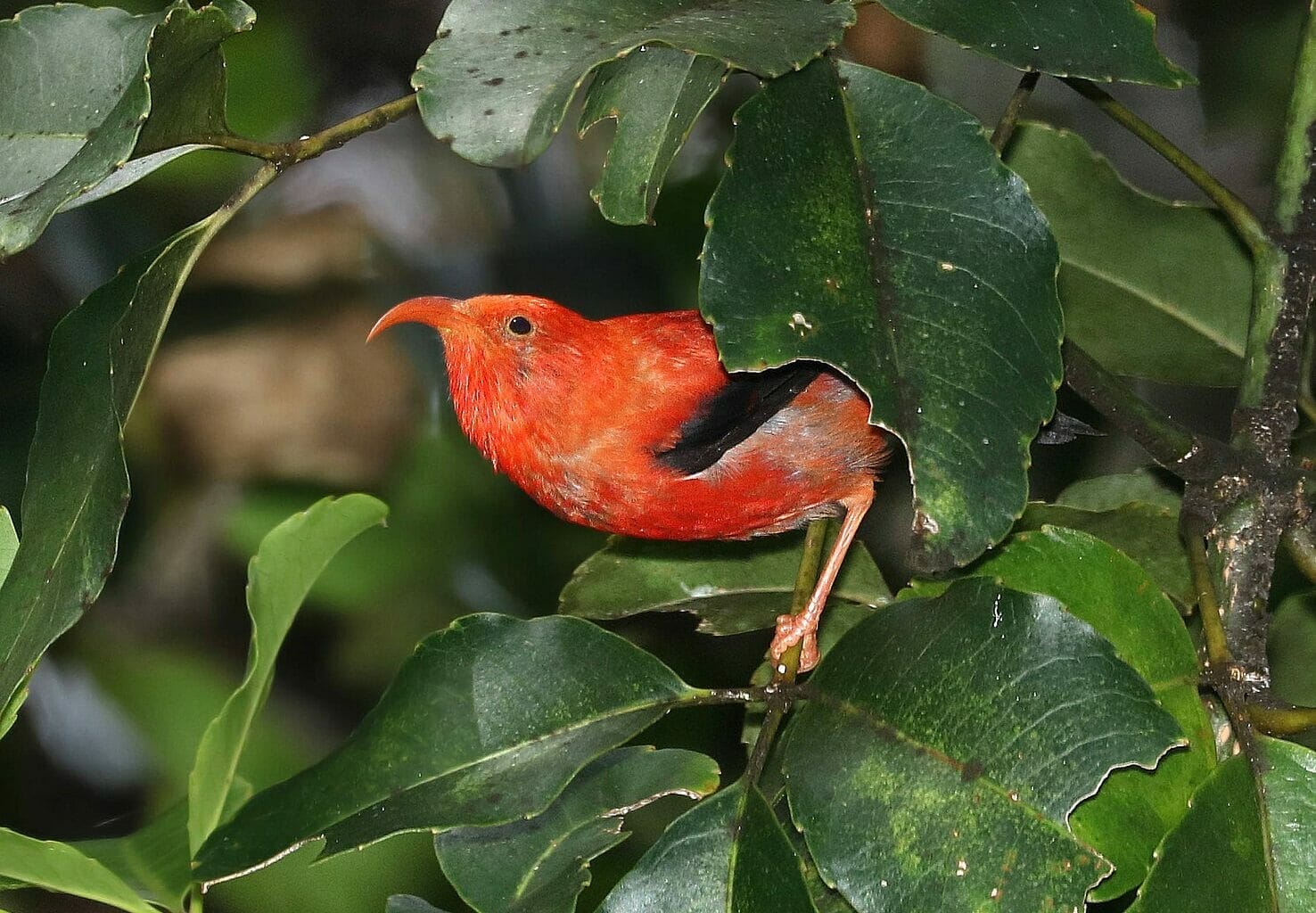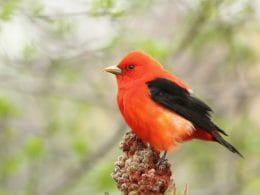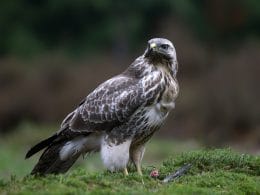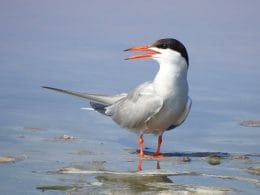Red birds are usually stunning. The vibrancy of their color is unusual in that birds do not actually have red feathers. Red feathers are cause by birds consuming foods that contain the pigment carotenoid. In this post, we look at the features of 13 red birds of the United States.
Northern Cardinal (Cardinalis cardinalis)
Identification

The male Red Cardinal is a vivid red songbird with a black face and a prominent crest. The female is an orangey brown with accents of red.
Size
- Length: 8.3-9.1 in (21-23 cm)
- Weight: 1.5-1.7 oz (42-48 g)
- Wingspan: 9.8-12.2 in (25-31 cm)
Range
The Northern Cardinal is widespread in the east and south of the United States. It is also present in parts of Canada and south into Mexico.
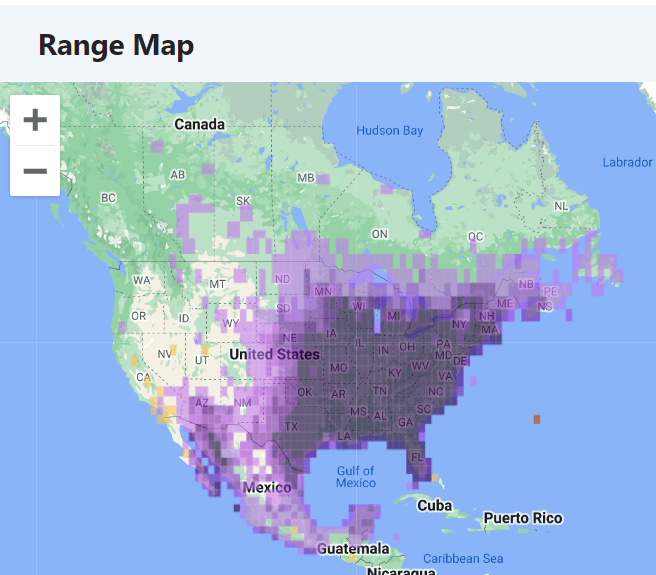
Facts
- Unlike some songbirds, the Northern Cardinal is not migratory and does not lose its vibrant color through molt. Therefore, it can be seen throughout the year in all its scarlet glory.
- The female Northern Cardinal is one of the few female bird species that sings. She will sing to her mate and while she is on the nest.
Summer Tanager (Piranga rubra)
Identification

The Summer Tanager male is bright red all over with a large bill. The female and juveniles are a dull yellow.
Size
- Length: 6.7 in (17 cm)
- Weight: 1 oz (29 g)
- Wingspan: 11-11.8 in (28-30 cm)
Range
The Summer Tanager visits the southern and north-eastern parts of the United States in the summer months to breed. It winters in Central and northern parts of South America.
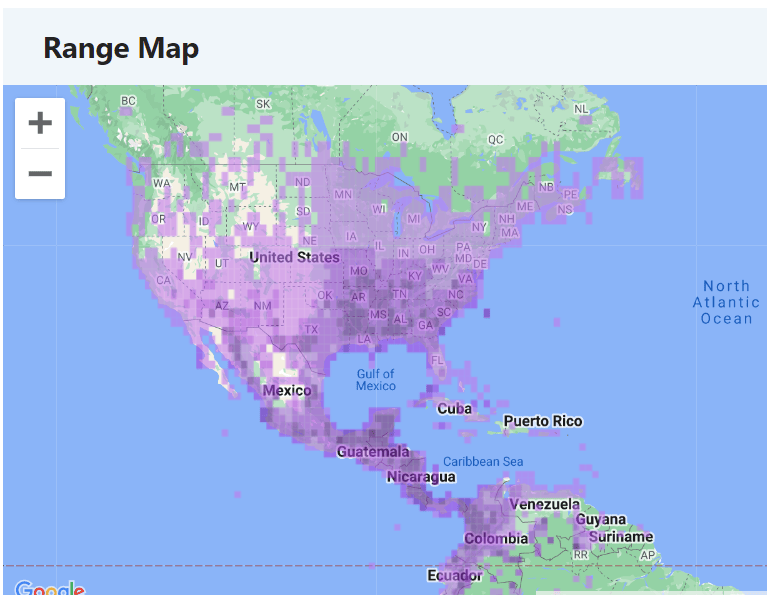
Facts
- The Summer Tanager is the only completely red colored bird on our list and in the United States.
- Even though it is bright red, the Summer Tanager is still hard to see. Take it from me, I didn’t see it for a long time until I tracked the call and got the photograph above.
Two-barred Crossbill (Loxia leucoptera)
Identification
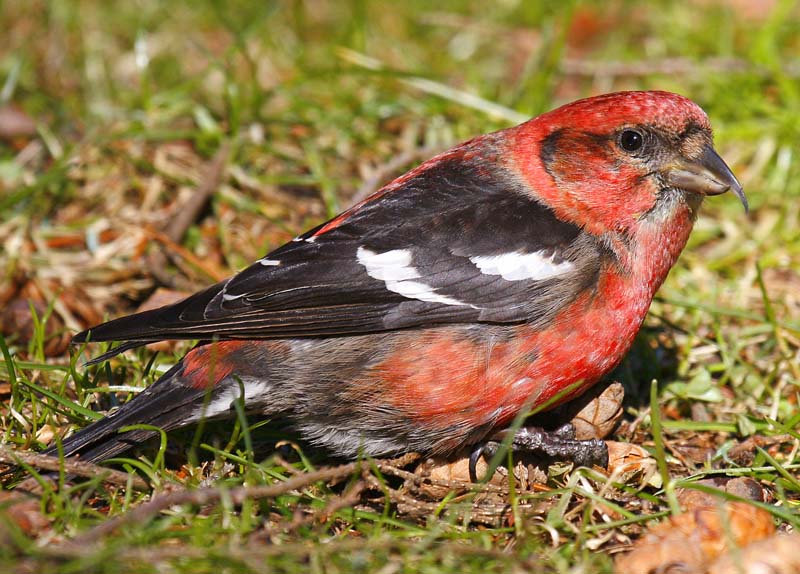
The Two-billed Crossbill is also known as the White-winged Crossbill. It is largely crimson with darker wings and distinctive white wing bars. The female has yellow instead of the red plumage.
Size
- Length: 5.9-6.7 in (15-17 cm)
- Weight: 0.8-0.9 oz (24-26 g)
- Wingspan: 10.2-11.0 in (26-28 cm)
Range
This crossbill is irregularly seen across northern states of continental America and in Alaska.
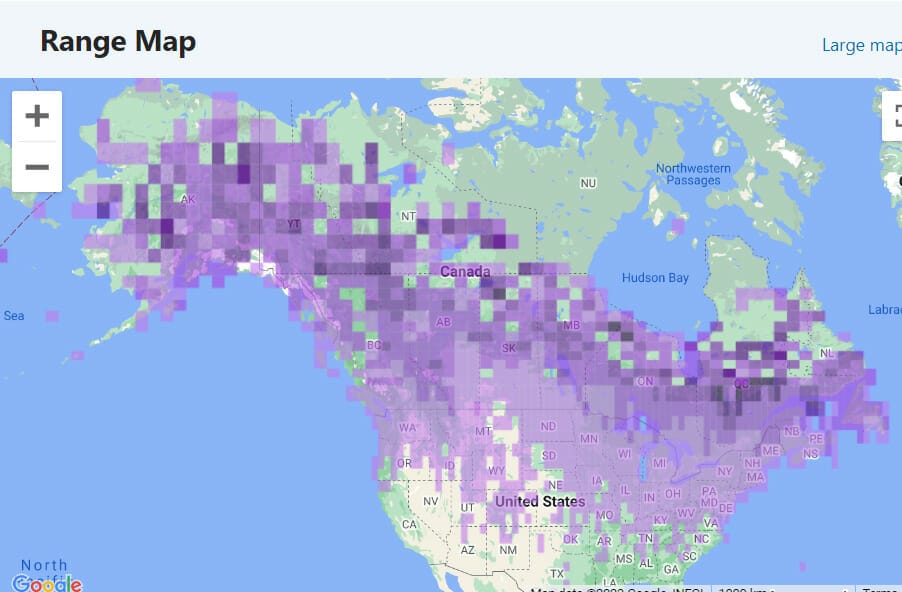
Facts
- The Two-billed Crossbill breeds at any time of the year depending on their location and the availability of food.
- This attractive crossbill is not common because it inhabits spruce forests in the northern parts of the continent and spends most of its time in the canopy.
Reddish Egret (Egretta rufescens)
Identification
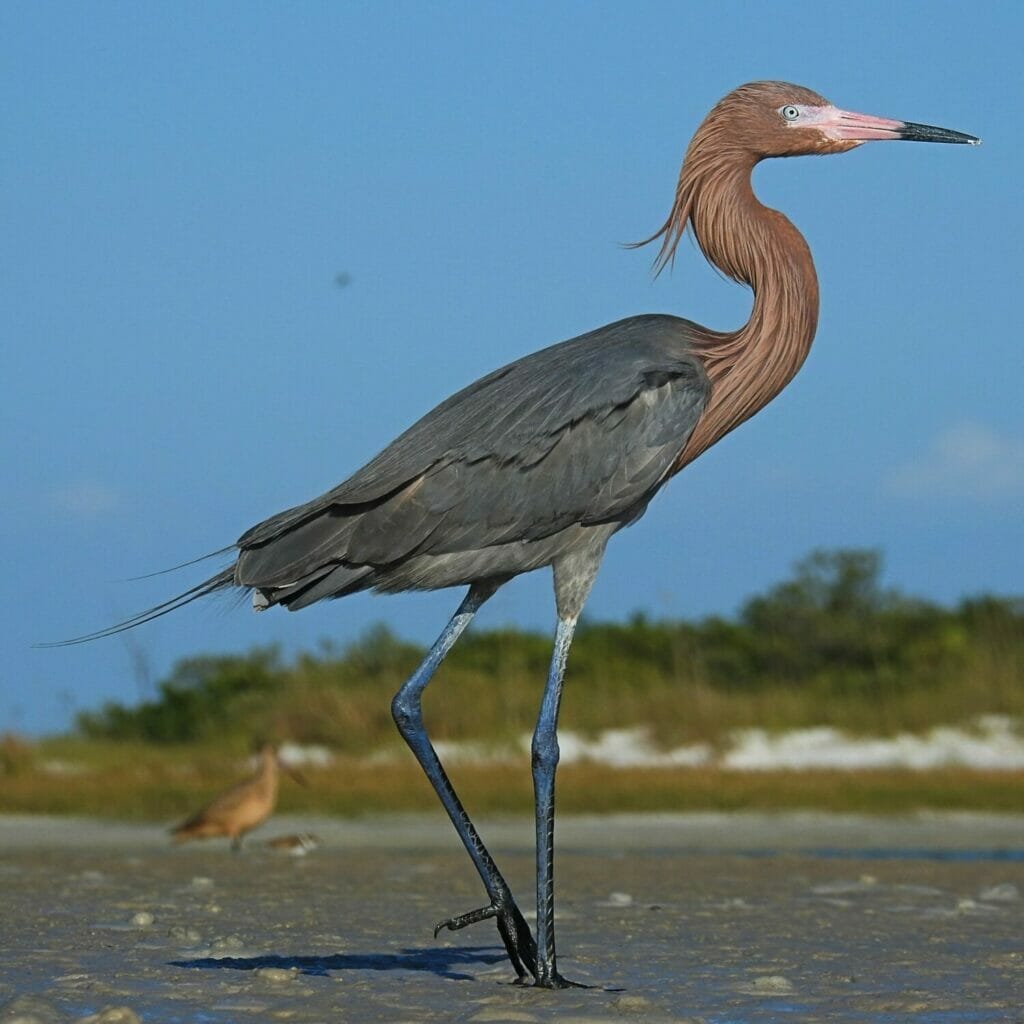
The Reddish Egret is a stunning waterbird, unlike most other herons. Its plumage ranges in coloration depending on age from white to red to red and gray.
Size
- Length: 27.6-31.5 in (70-80 cm)
- Weight: 24.7-30.0 oz (700-850 g)
- Wingspan: 45.3-46.5 in (115-118 cm)
Range
The Reddish Egret is an uncommon sighting across the south of the United States, found mostly on the coast. It is more common in Florida and on the south west coast.

Facts
- The Reddish Egret seems to be color blind. They do not take into account the morph of their mate and a nest can have chicks of both morphs in it.
- There have been cases where the dark morph egret has white feathers as well. Scientists do not know if this is a leucistic condition or breeding with other heron species.
Red Knot (Calidris canutus)
Identification
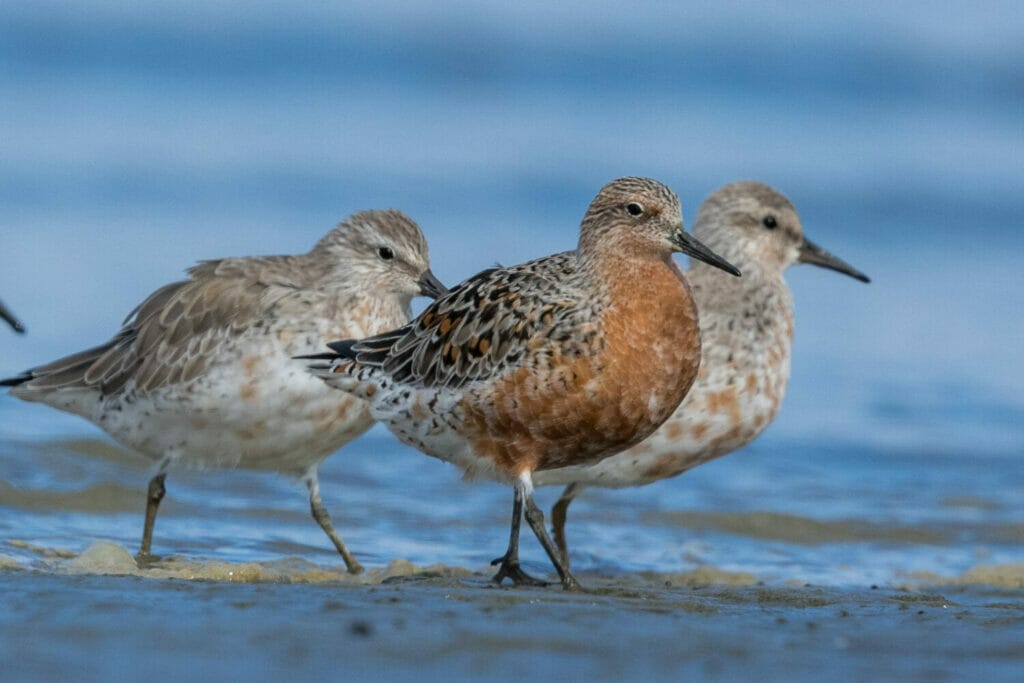
In breeding plumage, the Red (or Lesser) Knot is spectacular. While the back and wings are of a dark scalloped pattern, the entire front of the bird is a rusty red color.
Size
- Length: 9.1-10.6 in (23-27 cm)
- Weight: 4.4-7.2 oz (125-205 g)
- Wingspan: 22.4-23.6 in (57-60 cm)
Range
The Red Knot is an irregular visitor to the United States, mostly pitching up on the coast. It can be found throughout the year, mostly en route to or from their breeding grounds.
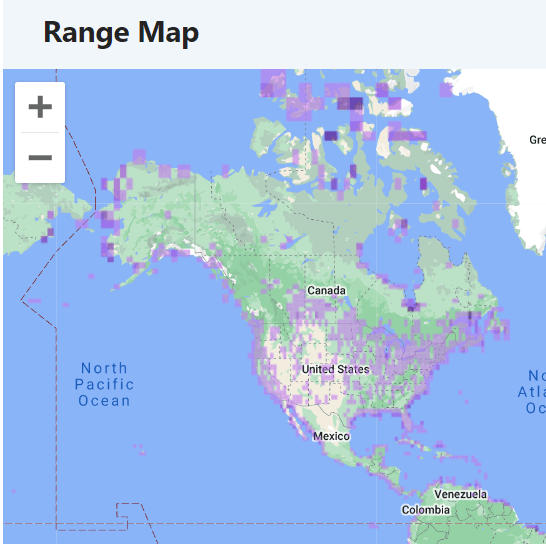
Facts
- The Red Knot have a gizzard, which is a specialized part of the gut that enables them to eat molluscks whole and crush them to extract the protein.
- The Red Knot complete the longest of migration journeys. They breed in the Arctic Circle and spend winters in places like New Zealand.
Red Avadavat (Amandava amandava)
Identification

The male Red Avadavat is bright red with some darker areas and has white spots on the flanks. The female is a gray/buff color.
Size
- Length: 3.7-3.9 in (9.5 – 10 cm)
- Weight: 0.25-0.34 oz (7.2-9.5 g)
Range
The Red Avadavat is a finch native to south-east Asia, India and Thailand in particular. It was introduced to Hawai’i and is now established there as a feral population. There are very few reports from continental America.
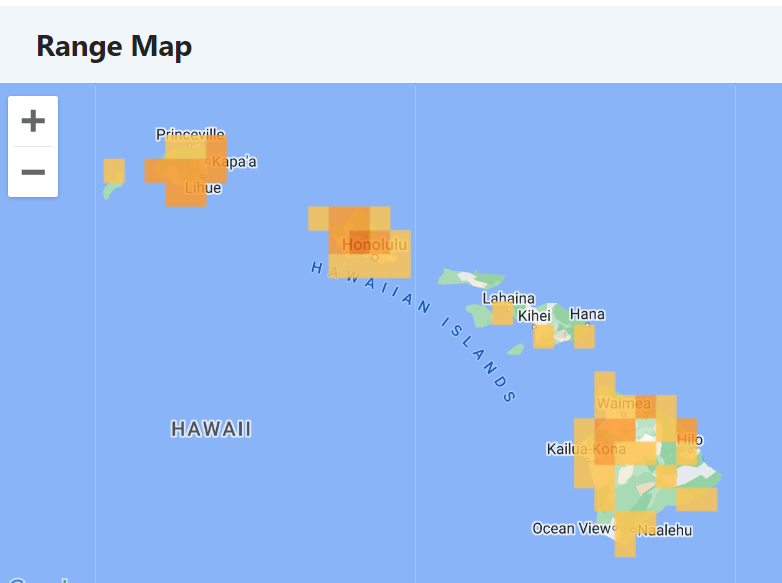
Facts
- While the Red Avadavat was introduced to Hawai’i, presumably for its attractive plumage, it was also taken to countries as far apart as southern Europe, Arabia and Hong Kong.
- Birds like the Red Avadavat are now shown in orange on the eBird Range Maps to illustrate that they are exotic escapee or feral populations.
Scarlet Tanager (Piranga olivacea)
Identification

The male bird is a brilliant scarlet color with black wings. The female and juveniles are a dull olive yellow color.
Size
- Length: 6.3-6.7 in (16-17 cm)
- Weight: 0.8-1.3 oz (23-38 g)
- Wingspan: 9.8-11.4 in (25-29 cm)
Range
The Scarlet Tanager is a summer visitor to the eastern parts of the United States, where it breeds. It winters in the Caribbean and Central America.
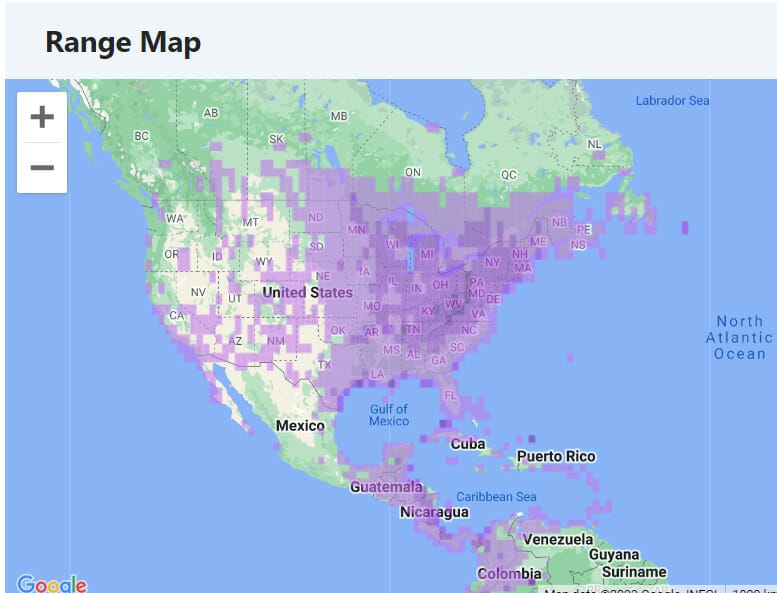
Facts
- Scarlet Tanagers may well be so brightly colored because of the bright fruits they love to eat, including june, straw and mul-berries.
- Whilst very bright, the Scarlet Tanager is another difficult to see tanager as it flits about high up in the canopy.
Rufous Hummingbird (Selasphorus rufus)
Identification
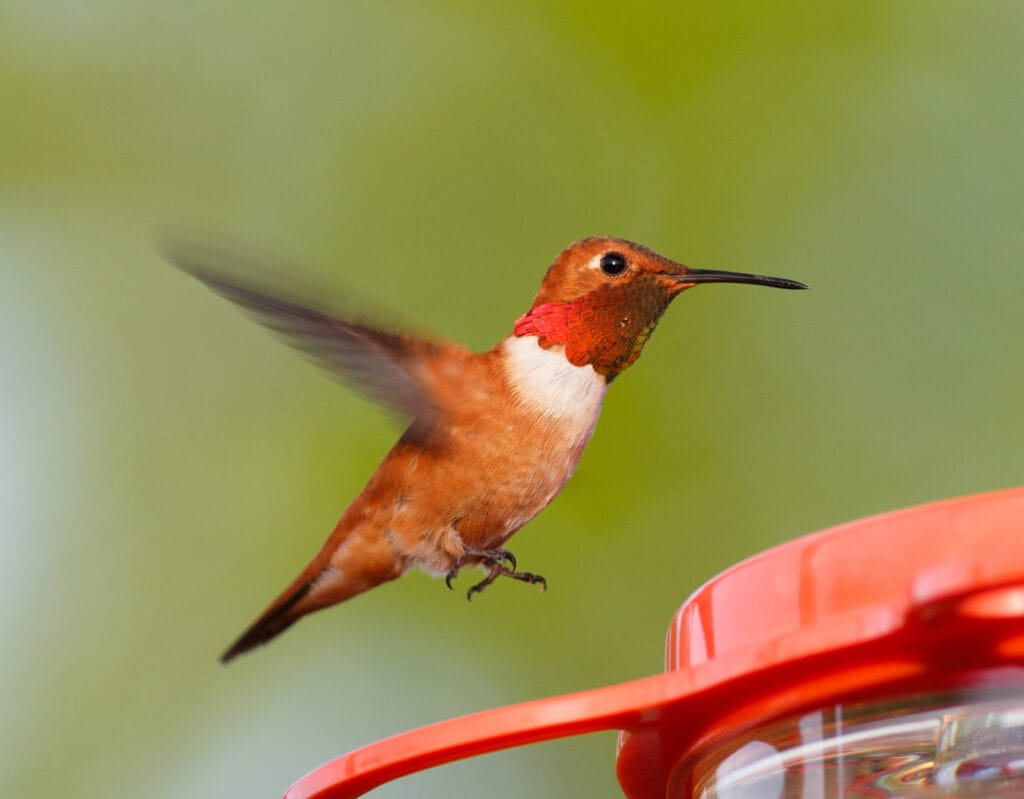
The male Rufous Hummingbird is largely shades of red and brown with iridescent scales on the throat. The female bird is duller overall, with orange flanks.
Size
- Length: 2.8-3.5 in (7-9 cm)
- Weight: 0.1-0.2 oz (2-5 g)
- Wingspan: 4.3 in (11 cm)
Range
The Rufous Hummingbird visits the United States to breed each summer. It can be found from Alaska throughout the western seaboard and into Mexico. It is less common on the eastern side.
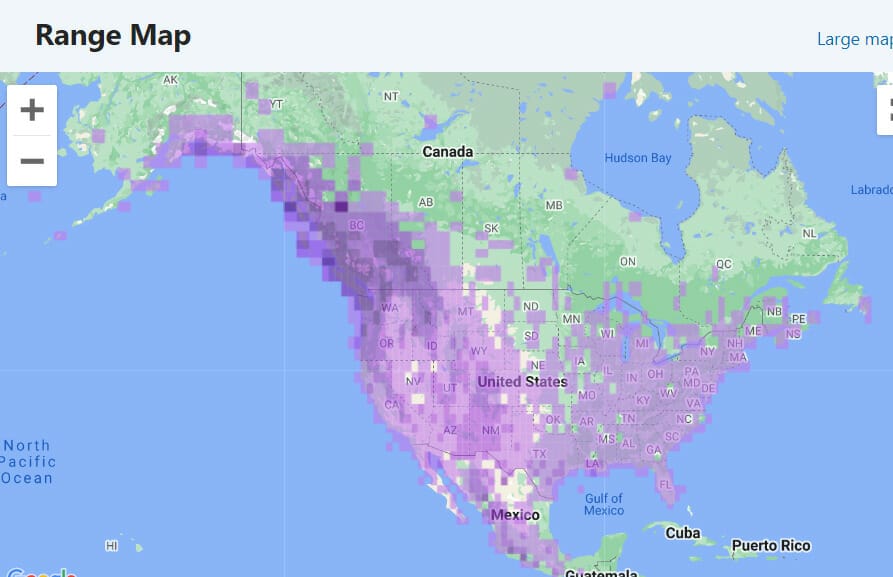
Facts
- The Rufous Hummingbird is an aggressive little bird and will claim territory in your garden if you put out hummingbird feeders.
- The migration route of the Rufous Hummingbird is interesting. They fly up to Canada and Alaska along the western seaboard and return south at the end of the breeding season flying along the Rockies.
Red-shouldered Hawk (Buteo lineatus)
Identification

The Red-shouldered Hawk is an attractive rufous and brown hawk with distinctive red patches at the top of the wings.
Size
- Length: 16.9-24.0 in (43-61 cm)
- Weight: 17.1-27.3 oz (486-774 g)
- Wingspan: 37.0-43.7 in (94-111 cm)
Range
The Red-shouldered Hawk is present all year round across the United States except for a wide tranche of land through the mid west.
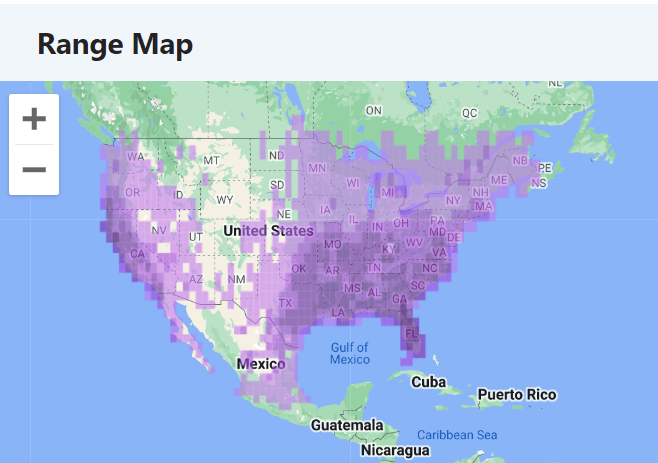
Facts
- The Red-shouldered Hawk has a distinctive whistle call which often means you hear the bird before you see it.
- This hawk will return to a satisfactory nesting area for many years.
Vermilion Flycatcher (Pyrocephalus rubinus)
Identification
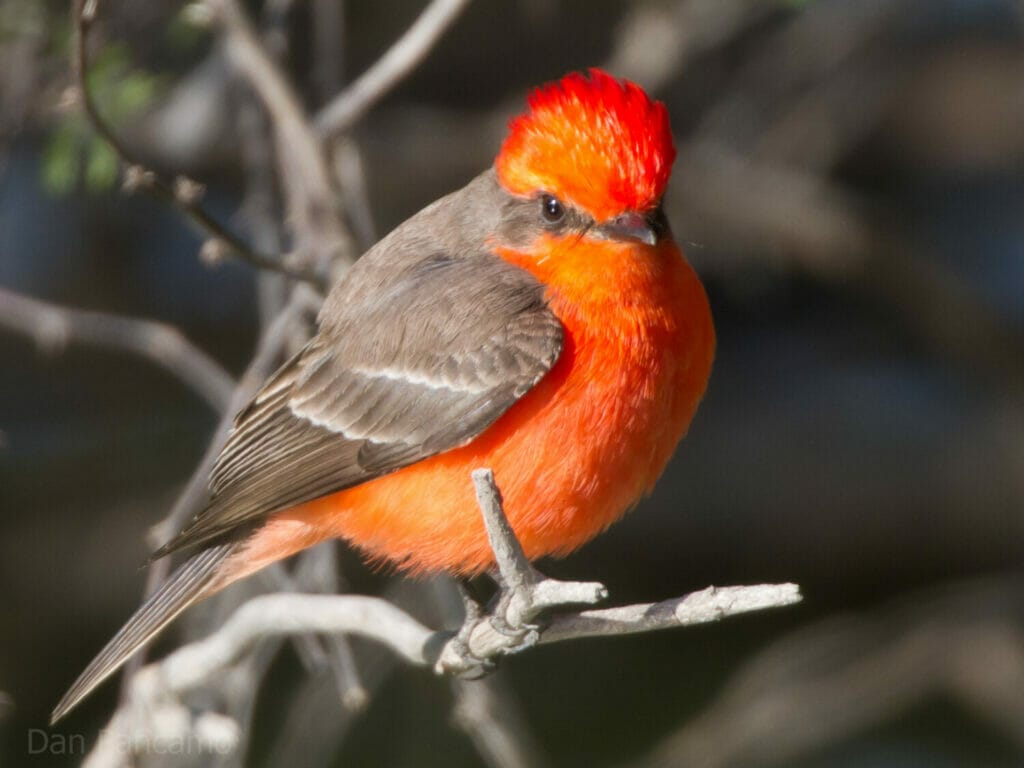
The male Vermilion Flycatcher has bright red under parts with a darker brown back and wings. The female and young birds are a duller, paler brown with red flanks.
Size
- Length: 5.1-5.5 in (13-14)
- Weight: 0.39-0.49 oz (11-14 g)
- Wingspan: 9.4-9.8 in (24-25 cm)
Range
The Vermilion Flycatcher is a regular but uncommon resident of continental America. It is more common further south.
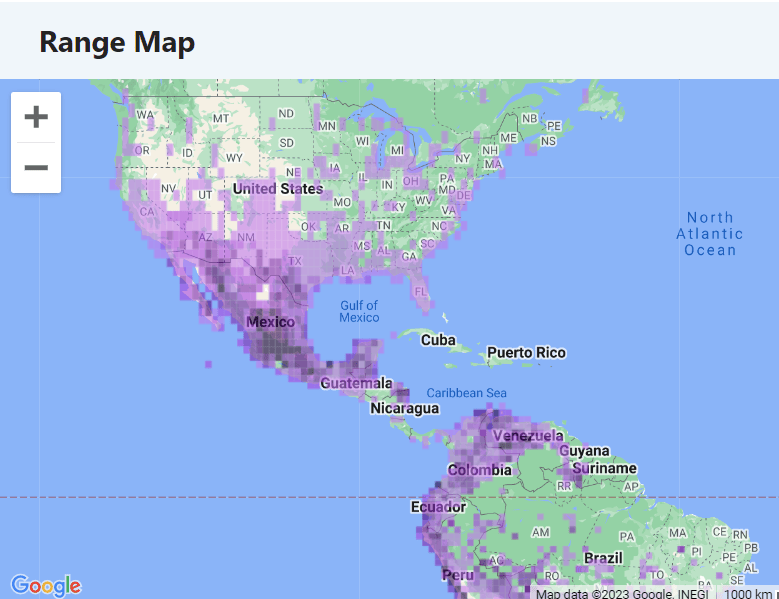
Facts
- The Vermilion Flycatcher can be found through South America, right to the tip.
- There are no less than 12 sub-species of the Vermilion Flycatcher.
House Finch (Haemorhous mexicanus)
Identification
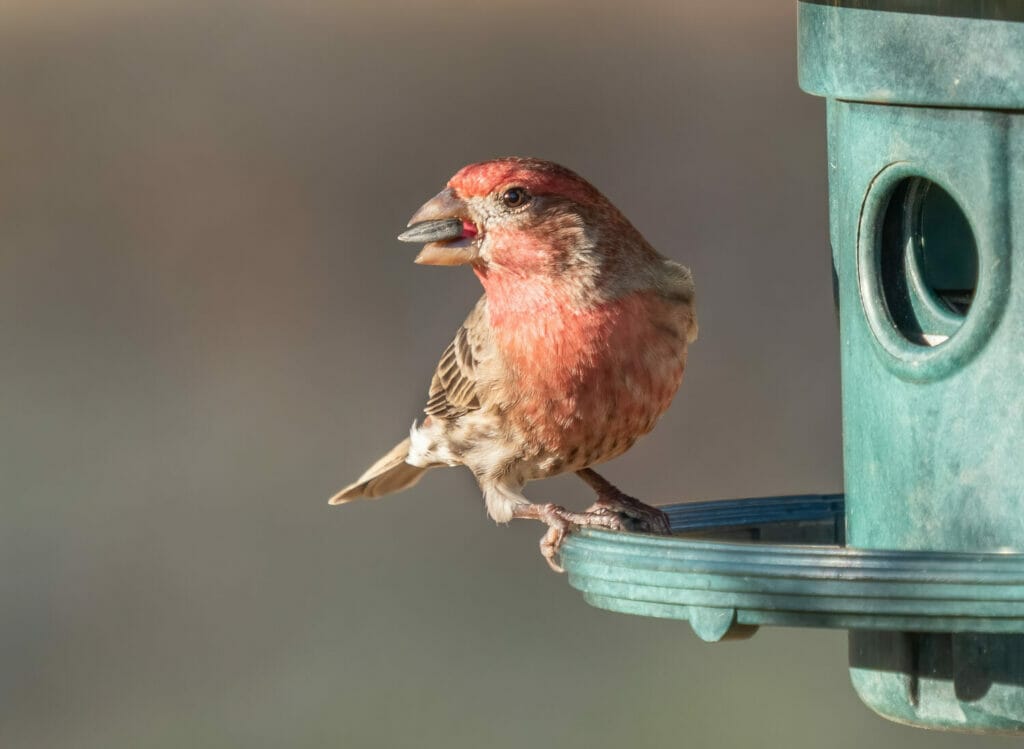
Female and young House Finches are a streaky brown and buff bird. The males are the same but with varying degrees and intensity of red around the breast and head.
Size
- Length: 5.1-5.5 in (13-14 cm)
- Weight: 0.6-0.9 oz (16-27 g)
- Wingspan: 7.9-9.8 in (20-25 cm)
Range
The House Finch can be seen across the United States all year round.
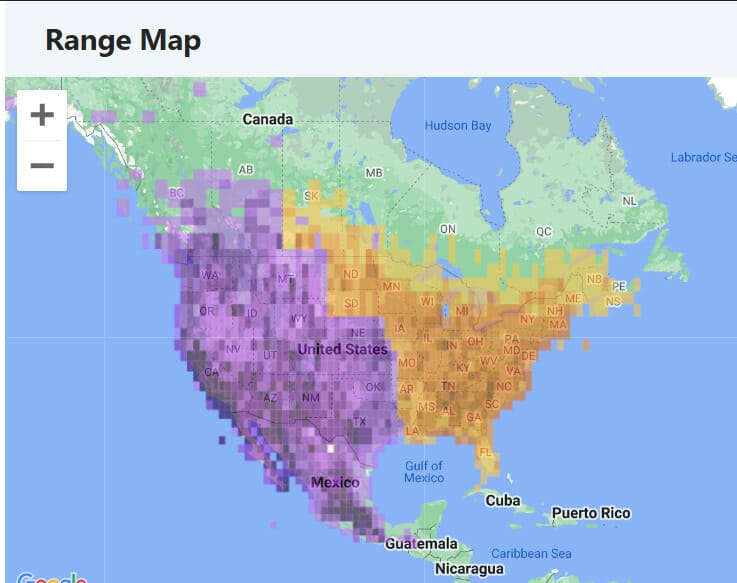
Facts
- The House Finch is native to the west of the U.S. and Mexico. They were transported to eastern side of the U.S. as captive songbirds. At some point birds were released or escaped and established feral populations. This is why there are different colors on the Range Map above. Purple is the native population and orange is the feral.
- The House Finch was also transported to Hawai’i and can now be found there as an exotic population.
Cinnamon Teal (Spatula cyanoptera)
Identification
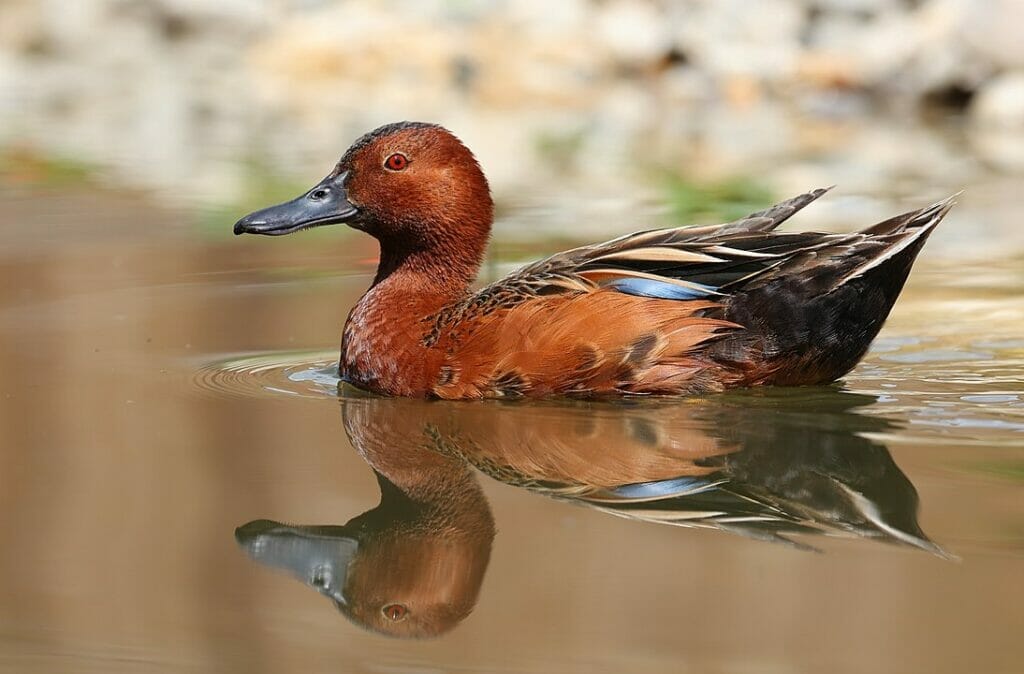
The female teal is a mallard-like streaky brown with a large bill. The male is a glorious red brown color.
Size
- Length: 15.1-16.9 in (38.4-42.8 cm)
- Weight: 11.8-14.1 oz (335-401 g)
- Wingspan: 21.3-22.4 in (54-57 cm)
Range
The Cinnamon Teal can be found across the United States including Alaska and Hawai’i in any appropriate body of water.

Facts
- The Cinnamon Teal is a dabbling duck found on the edges of wetlands and shallow marshes.
- The female teal goes to great lengths to protect and disguise her nest and often has to approach it by swimming underneath the water.
ʻIʻiwi (Drepanis coccinea)
Identification

The ʻIʻiwi is a brilliant red colored honeycreeper with black wings and white wingbar. The long, curved bill is a paler red.
Size
- Length: 6 in (15 cm)
- Weight: 0.6-0.7 oz (16-20 cm)
Range
The ʻIʻiwi is an uncommonly seen honeycreeper found across the inhabited islands of Hawai’i.

Facts
- The name of the ʻIʻiwi is derived from a reference to the Bristled-thighed Curlew as the shape of the bills are similar.
- While it is uncommonly reported across Hawai’i, it actually believed to have relatively healthy populations across nearly 50 of the Hawaiian Islands.
Conclusion
So there are all the regularly seen totally (or nearly) red birds of the United States. Hard to choose a favorite as they are all so glorious but I guess mine would be the Summer Tanager as I have seen and watched it. I was stunned by how beautiful it was.
I hope you have enjoyed reading our list of red birds as much as I did writing it!
FAQ
What are red birds in Texas called?
What are the bright red birds in Michigan?
I’ll save you some time. If you see a red bird with a crest anywhere in the U.S., it is likely to be the Northern Cardinal! It is possibly the most commonly seen bird across the country.
This one would have made the list if it just had a bit more red on it. If the bird you are looking at has a totally vivid red head then it is the Red-headed Woodpecker.
If it is the Northern Cardinal, then there are several spiritual and cultural interpretations like devotion, and love.




